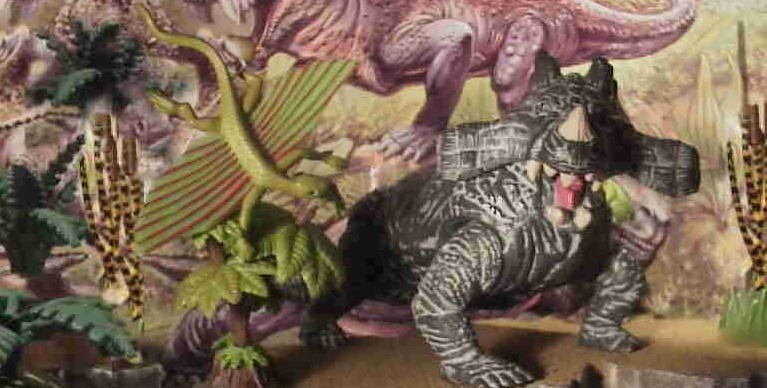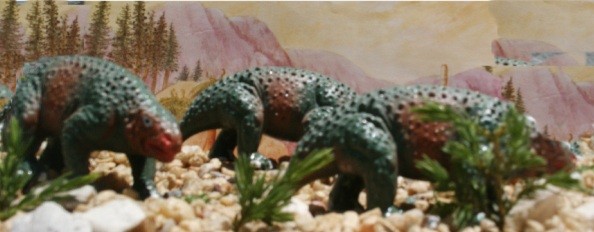Middle Permian
The oldest of the proto mammals sometimes called mammal like reptiles are found in the the Russian province of Kazan hence the name. The equivalent in of the tapinecehaleus zone found in South Africa. Animal life spread out from the equator to temperate zones. Dinocephalians like the giant plant eater Moschops and Estemmenosuchus, dominate the first part of the Late Permian, the Kazanian, but die out before the great extinction Anaspids once thought to be related to modern turtles are less common. They evolve some superficially lizard like forms and giant plant eating pareiasaurs like Scutosaurus that continue until the great extinction. Diaspids the ancestors of the dinosaurs, birds and living reptiles are uncommon. They fill niches as lizard types, gliders and aquatic reptiles. Plants are different from the southern continents. Ginkgoes, cycadoids, trees ferns, horse tails with primative conifirs made flora in an landscape of braided rivers and swamps.
The Kazanian fauna. Scutosaurus had the typical pareiasaur massive body, spiked head and bony
Scutosaurus had the typical pareiasaur massive body, spiked head and bony
armor developed to an extreme. Instrancevia gorgonopsid bear sized lived in Russia.

Estemmosuchus had horn-like projections. It is decribed as primative and may have deveoped into a large plant eater independent of the dinocephalians. It was a bull sized animal restricted to the Orcher Complex in Russia which is the equivalent of the Eodicynodon zone in South Africa.

Ulemosaurus was closely related to Moschops. Both were tapinocephalids, a group of bulky herbivores.
 Scutosaurus had the typical pareiasaur massive body, spiked head and bony
armor developed to an extreme. They were heavy ungainly animals, the size of an ox, with capacious bodies, strong limbs, broad feet, and thick solid skulls ornamented with bizarre knobs and ridges. They were armoured with bony scutes or osteoderms set in the skin.
Scutosaurus had the typical pareiasaur massive body, spiked head and bony
armor developed to an extreme. They were heavy ungainly animals, the size of an ox, with capacious bodies, strong limbs, broad feet, and thick solid skulls ornamented with bizarre knobs and ridges. They were armoured with bony scutes or osteoderms set in the skin.
It has been often suggested that these animals were semi-aquatic. Skeletons have been found in a standing position, indicating that the animals became mired in the mud and swamps while feeding on vegetation. Their remains are also consistently found in channel stream deposits (riverbeds). Of course, this does no mean that they were semi-aquatic; and actually the fact that the animals became stuck argues against aquatic adaptations (a aquatic animal would not likely become stuck, whereas a terrestrial animal would; e.g. the remains of sauropod dinosaurs, which were as terrestrial as elephants, are sometimes found in this position). Perhaps a better model would be the giant land tortoise given the increasingly arid environment.
